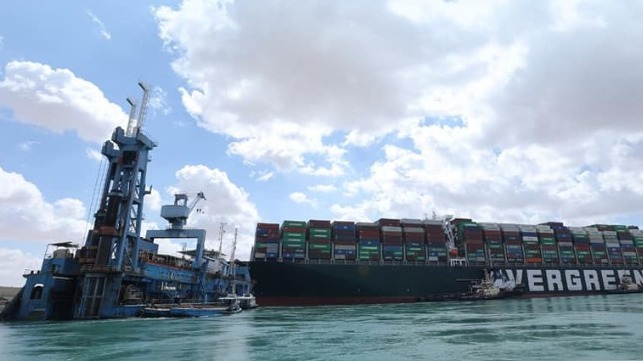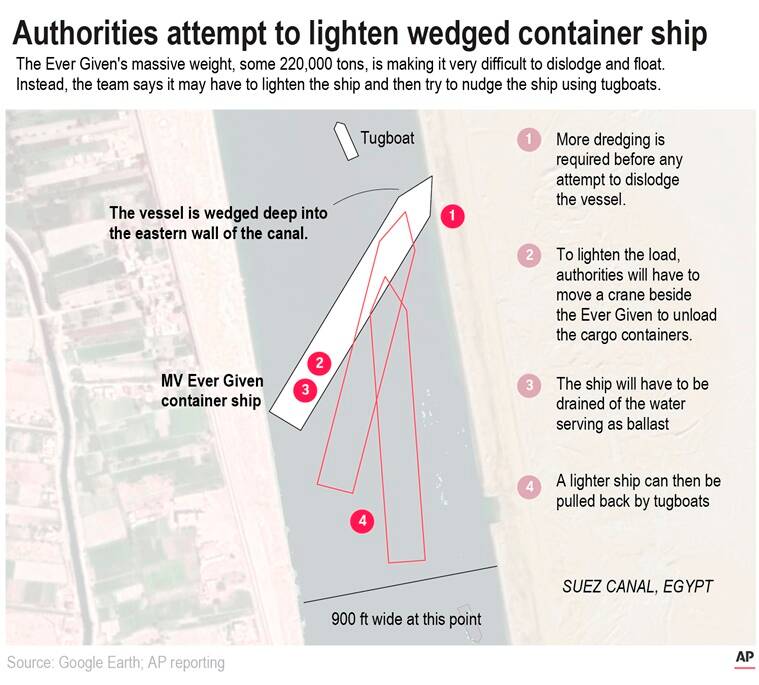The Suez Canal Block began on 23rd March and ended with a high tide helping the tugboats in wrenching the bow of the skyscraper-sized ‘Ever Given’ from the sandy bank of the crucial waterway on 29th March.

Brief about Ever Given
The official name of the ship is ‘Ever Given’ and it is operated by Evergreen Marine, a Taiwanese company. Talking about the incident, Suez Canal in Egypt was choked by the mega container ship ‘Ever Given’ on 23rd March, paralyzing what is one of the world’s busiest trade routes until 29th March. Getting down to facts, the forecast for Tuesday, March 23, showed wind gusts of over 40 miles per hour and sand storms sweeping through northern Egypt. And such weather is indeed common in the Sinai desert at this time of year. During this period, ships, including the world’s biggest container vessels, the Ever Given were forming the daily convoy. And as the gusts picked up, Ever Given’s decision to join the precious waterways reverberated globally in a matter of just a few hours.
Must Read: What Customer Experience Looks Like in 2021
The Incident: Suez Canal Block 2021
At around 7:40 a.m. local time, Ever Given, loaded with containers, that would stretch more than 120 kilometers (75 miles) end-to-end and carrying everything from frozen fish to furniture was declared to have been stuck. The Ever Given, built-in 2018 with a length of nearly 400 meters (a quarter-mile) and a width of 59 meters (193 feet), is among the largest cargo ships in the world and can carry some 20,000 containers at one single time.
This ship was heading through the 300 meter-wide canal at a time when one ship decided to hold off due to the high winds and two slightly smaller container ships immediately ahead of Ever Given employed tug boats to take precautions from the gusts. According to the email sent out by Taiwan-based Evergreen, the time charterer of the vessel was grounded accidentally after deviating from its course due to suspected sudden strong wind.
Next was the issue of how fast the ship was going. According to reports, when the ship began to move towards the sand, it appeared to have been speeding up, perhaps to correct itself. But, it was too late and the ship almost collided with the bank. That served to wedge the steel hull even more deeply into the side of the canal.

Also Read: Supply Chains Moving from Globalization to Regionalization
Ever Given Rescued
In an effort to dislodge the ship, over 20,000 tons of sand had been removed on Saturday, 27 March, and around 14 tugboats pulled and pushed the ship to clear the waterway for the convoy to flow through. Efforts to free the 2,20,000 ton Ever Given continued all throughout the 6 days and eventually the President of Egypt, Abdel Fattah el-Sisi ordered preparations to unload the giant container ship if last-ditch efforts fail to dislodge it. This decision came through as the closure of the canal could drag on for weeks, thus damaging businesses worldwide.
Dredgers, tugboats, and even backhoe failed to free up the giant cargo ship wedged in the Suez Canal. Aside from that over 150 vessels backed up, with hundreds more heading to the vital waterway. The losses to global shipping were only mounting. With such consequences, after 6 long days of efforts to free the Ever Given, it was the high tide and the efforts of all rescuers that helped in re-floating the Ever Given.
The Consequences of the 2021 Suez Canal Blockage
From toilet paper and coffee to furniture, etc there are several products that could be short in supply just because of the Suez Canal blockage. According to analysis from Russell, the Evergreen container ship, after plunging one of the world’s busiest trade routes into chaos, could be carrying goods worth $89 million and threatens to create over $40 billion dollars of trade disruption.
Even before the blockage, businesses reported that they were struggling with supply shortages because of the coronavirus pandemic. That being said a list of companies including Nike, Costco, Toyota, Honda, and Samsung also recently said that supply chain issues were harming their businesses this quarter. They also predicted that this would likely have an impact going forward. The Suez Canal logjam has added more layers to delays and shortages. According to experts from the industry, the blockage is costing about $400 million per hour. As a way to find quick solutions, some ships are even taking an alternate route around Africa, adding around 15,000 miles and about two weeks to their journey. And while we’re discussing the consequences, it is only right to mention the effect that such an incident causes on the prices of oils. The results are disastrous.
What is the Suez Canal?
In the 150 years since the canal was built, the route has served as an artery that connects the Mediterranean Sea with the Red Sea. It provides an avenue for vessels to pass between Asia, the Middle East, and Europe and accounts for nearly 12% of global trade moves.
Future Expectations of the Suez Canal
Andrew Kinsey, a former captain who navigated a 300-meter cargo ship through the Suez and currently Senior Marine Risk Consultant at Allianz Global Corporate & Specialty said that the workers on such ships were in for some white knuckle rides because the canal is very small. He added that with the winds being so rough, there is hardly a margin for error and when errors do happen, the consequences are quite big.
Recommended Read: Real-Time Data is Key for Stronger Supply Chains in 2021
For more articles like “The Harsh Consequences of the Suez Canal Blockage”, follow us on Facebook, Twitter, and LinkedIn.